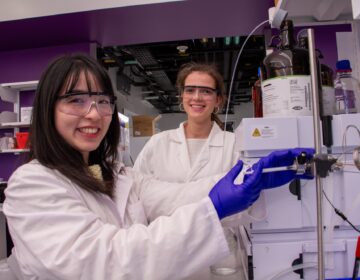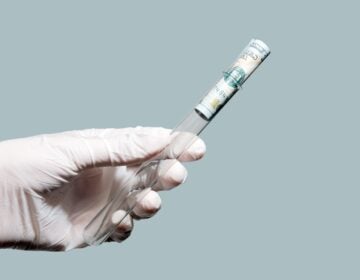Autopsies contribute valuable scientific data, but they’ve become rare
Listen 5:15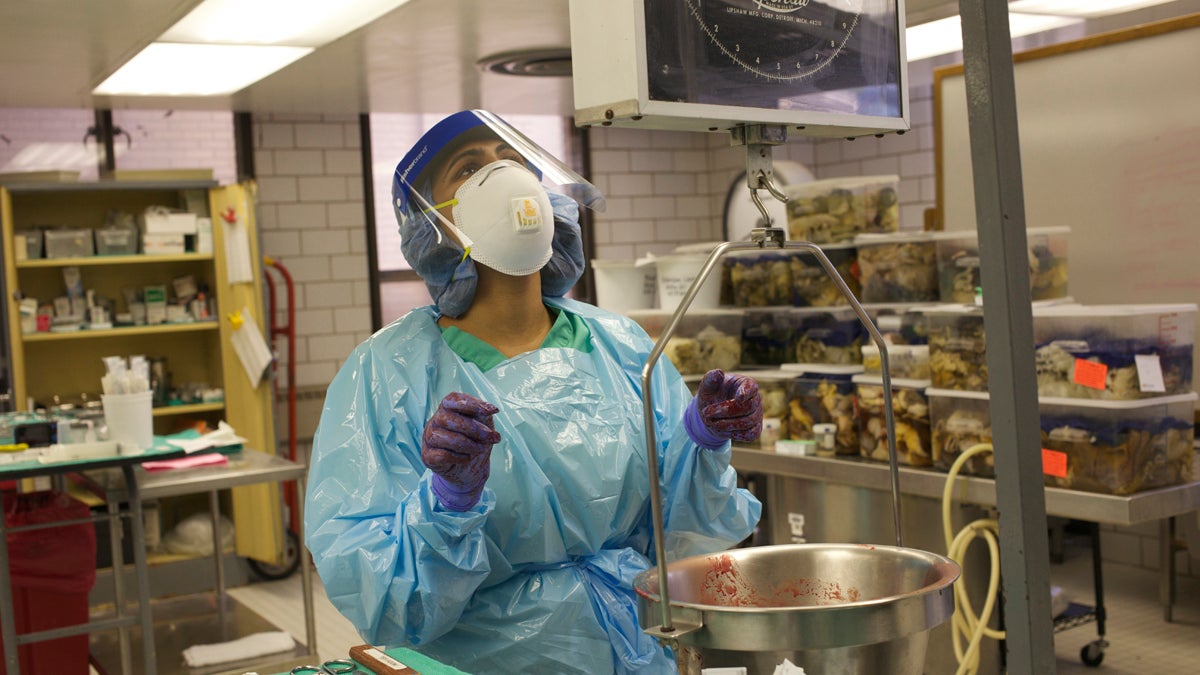
Shraddha Patel, a first year pathology resident, weighs organs during an autopsy. (Irina Zhorov/The Pulse)
Dr. Robert Ownbey, a pathologist who heads up the Hahnemann Hospital autopsy unit in Philadelphia, suited up in a blue plastic gown and latex gloves before approaching the patient. The man on the metal table was 64 years old, 170 pounds, and his medical history included hypertension and Parkinson’s for 30 years. He died three days prior to Ownbey’s visit.
This piece is part of our “Bodies” show. Take a look at the rest of our stories here.
Warning: The images below are graphic.
Dr. Robert Ownbey, a pathologist who heads up the Hahnemann Hospital autopsy unit in Philadelphia, suited up in a blue plastic gown and latex gloves before approaching the patient. The man on the metal table was 64 years old, 170 pounds, and his medical history included hypertension and Parkinson’s for 30 years. He died three days prior to Ownbey’s visit.
Ownbey, a team of residents, and a technician, whose job it is to do the actual cutting, were investigating what killed the man and what was going on in his body at the time of death.
The patient’s family had requested the autopsy to figure out a cause of death – doctors suspected stroke, but could not confirm – and check for any genetic issues they should be aware of.
The Joint Commission on Accreditation of Hospital (now called The Joint Commission) used to require hospitals to perform autopsies on at least 20 percent of patients who died on premises. Many autopsied more. But in 1970 the requirement was lifted and autopsy numbers have been falling ever since.
In 2014, hospitals autopsied an average of 7.7 percent of patients. Not counting those who died of external causes, like a car accident, hospitals autopsied an average of just 3.9 percent of patients that year.
Hahnemann Hospital autopsies 11 percent of patients who die there and accepts patients from the region, as well. This patient came from outside the hospital.
It can be hard to ask families to sign off on the procedure, insurance often doesn’t cover it (an autopsy can cost $1,000 to $5,000, if a hospital doesn’t offer it for free), and technology has made doctors increasingly trusting in their diagnoses.
Still, many doctors, including Ownbey, say more autopsies are necessary.
The autopsy
The procedure is hands-on. “You use four of your five senses,” Ownbey said. “You can guess which one you don’t use.”
At this particular autopsy, the residents started with a physical exam, feeling for abnormalities. When they were ready to cut, they covered his face and genitals with blue towels.
Fred Rathof, the technician, made a Y-incision, two diagonal cuts on the chest and one down the belly. He pulled back the skin, with its layer of yellow fat tissue, to reveal the bowels.
The rib cage covered the organs. Rathof prepared to saw into it, to remove it. He told a pathologists’ assistant student witnessing her first autopsy that it’s okay to draw a line along which to saw. “Many people will give themselves a guide, but I’ve been doing this so long I really don’t need it,” Rathof said. He’s been performing autopsies for nearly 20 years.
“Be careful not to cut yourself or anyone near you,” he instructed the student. “Remember when you’re cutting and you see spurting blood, it is not the patient.”
When he opened the chest cavity, he revealed pink lungs. “Non-smoker,” Ownbey marveled. “Wow.”
In hospital autopsies, organs are usually taken out in blocks, so the pathologists can see if there were problems in the connections between organs. Rathof worked to separate the gastric system from the heart and lungs and handed the organs to the residents in metal bowls.
On the other side of the room, the residents weighed, measured, checked for abnormalities and prepared the organs for further examination under a microscope.
Aside from unusually large lymph nodes and masses in the testes, all of this man’s organs seemed impeccable in the initial examination. But the exam would begin all over again under the microscope the next day. It’ll be a couple of months before the team issues a complete autopsy report with their findings as to the cause of his death.
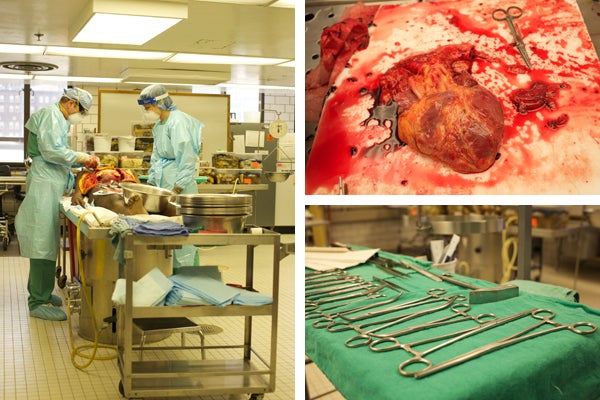
Quality control
While families may get closure from the information an autopsy supplies, for doctors, it’s about quality control. “Autopsies are still important for clinical audition of clinical service,” said Abir Mukherjee, director of the autopsy lab at Temple University Hospital, in Philadelphia. Temple’s autopsy rate has gone from 18 percent, in 2010, to about 10 percent last year.
“We often find things that are unexpected at autopsy,” Ownbey said.
Studies have repeatedly shown that autopsies turn up contradicting causes of death. For example, a doctor blames pneumonia, but an autopsy reveals that it was actually a tumor.
“That’s despite the fact that we have all this technology, this wonderful imaging that’s very specific, all these different kinds of lab tests,” Ownbey said.
To demonstrate, he talked about an elderly woman that came into the hospital with vague abdominal pains. Doctors checked her gastrointestinal tract but found nothing wrong, and just treated her for symptoms. She passed away soon after. At autopsy, Ownbey said, the team found that a whole portion of her intestine was completely dead. The gangrenous tissue sent bacteria into her bloodstream and killed her.
Jody Hooper, Director of Autopsy at Johns Hopkins University, echoed Ownbey. “We think we know everything but we don’t necessarily.”
Doctors can also see how a treatment, like chemotherapy or radiation, for example, affected a patient. Was the therapy destroying the tumor?
From everything they learn, doctors and residents may approach similar patients differently in the future. In other cases, it’s confirmation that a doctor could not have done anything else to help the patient.
Research and education
Aside from continuing education for doctors and residents, data gleaned from autopsies contributes to research.
“We’re contributing to the body of science with what we find,” said Adeola Tomi-Olugbodi, a third year resident in pathology at Hahnemann, as she systematically went through the patient’s organs. “We corroborate what we find clinically, grossly, microscopic, we put everything together, we compare to what has been found in other people, and that is how data is generated, how you are able to tell about different diseases.”
“There are some diseases for which the cause is not known, and for those, it’s critical to get human tissues,” said Temple’s Mukherjee.
During each autopsy, Hooper, at John Hopkins, is often supplying three to five different researchers with cells to study different issues.
“It’s a benefit but not always to the very patient being autopsied,” Hooper said. “Sometimes it’s a larger or a longer view benefit to future patients, to future care, and as we know, it’s always harder to take the longer view than to take the shorter view.”
Hooper does a lot of outreach at her hospital and in the greater medical community, encouraging physicians to ask families to consent to autopsies. Johns Hopkins autopsies 25 to 30 percent of people who die in the hospital.
Sensitivities
Some families are just never asked to consider an autopsy, but others, when asked, say no.
It can be because they don’t know what it involves or the purpose of the procedure. Other times, they have concerns about what shape the body will be in for the funeral, especially if they want to have an open casket.
Rathof was conscious of this as he worked. “You have to be careful,” he instructed a student at one point. “If the family wants to see the body, everything that we do will be covered by clothing.”
Cultural and religious norms can influence some decisions, too. For Ownbey, “religion and the mystery about what happens after death comes into play. Am I going to need my organs when [I die]? Realistically, of course, no. But yeah, I think I probably would want an autopsy performed.”
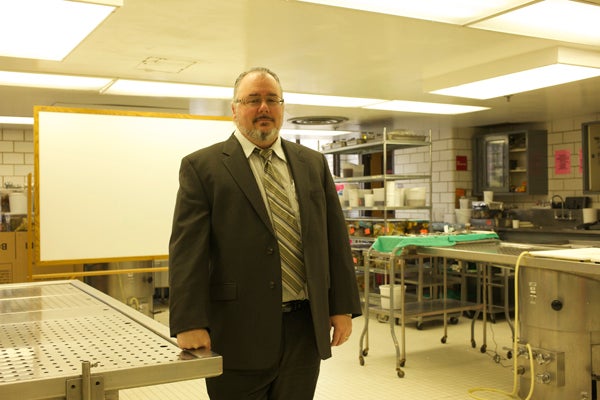
WHYY is your source for fact-based, in-depth journalism and information. As a nonprofit organization, we rely on financial support from readers like you. Please give today.




